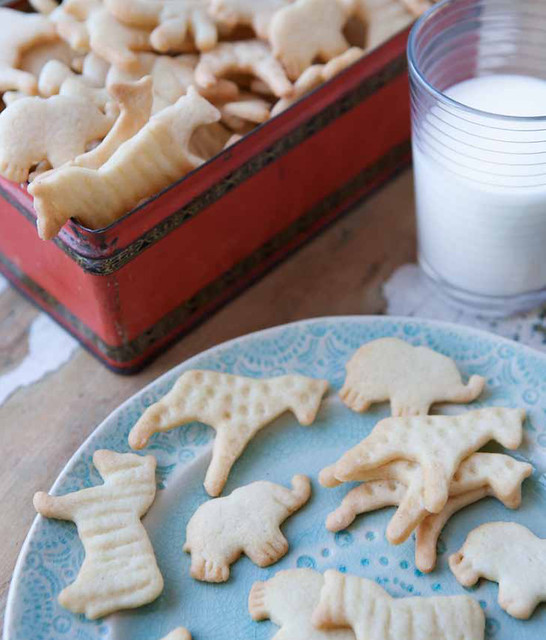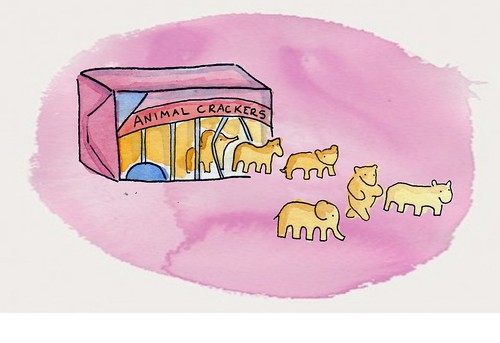CakeSpy Note: Sometimes, I like doing sweet things for you, readers. And so I decided to share an inside look at one of my favorite stories--and recipes!--from my new book, The Secret Lives of Baked Goods: Sweet Stories & Recipes for America's Favorite Desserts. This tale is all about animal crackers. Enjoy!
“Animal crackers and cocoa to drink that is the finest of suppers I think; when I am grown up and have what I please I think I shall always insist upon these.”
—Actor and writer Christopher Morley
Everyone loves those curious animal-shaped cookies that pack a crunch and are called “crackers.” But how is it that these proud little animals began marching their way into our mouths and hearts?
Well. The custom of crafting cookies that resemble creatures is nothing new— as early as the 1600s in Germany, bakers were making sweet treats resembling savage beasts. But it wasn’t until the 1800s that the wheels began to turn, set- ting off the chain reaction that made these sweet crackers a snacking staple. For this we owe a thank-you to the industrial revolution: that’s when biscuits, cookies, and crackers began to be manufactured in factories.
In Victorian England, “crisp biscuits”—that’s sweet, cracker-like cookies, to Americans— were very popular. Some of these biscuits were shaped like animals. A hint of things to come was evident when Zoologicals, animal-shaped cook- ies made by Philadelphia baker Walter G. Wilson, were sold at the Centennial Exposition of 1876—the first world’s fair in America. (This pivotal event yielded many innovations, including the introduction of the Dewey Decimal system, the ice cream soda, and the grand debut of the Statue of Liberty’s torch, before it was affixed to the rest of her body in New York City.)
After acquiring two New York City bakeries that produced animal-shaped biscuits, the National Biscuit Company (later Nabisco) began producing animal-shaped biscuits on a commercial scale which allowed for widespread distribution.
Serendipitously, this timing coincided with P. T. Barnum’s growing reputation as an international showman and circus owner. Perhaps sensing a sales opportunity, several companies had begun marketing foods of all sorts with circus-themed packaging, and these biscuits were a natural tie-in. The National Biscuit Company did it most famously, with their 1902 debut of the animal-shaped crackers. Marketed as a specialty holiday item, they were sold in a small box resembling a circus cage with a handle at the top, for displaying as an ornament.
The crackers proved so popular that they were soon being produced year-round, the ornament string promoted as an easy way for children to transport the cookies. In 1948, they were renamed Barnum’s Animal Crackers, which is what they’re still called today. But for all the glittering success of the Barnum associa- tion, the circus man did not receive payment for the use of his name: according to an article in the Washington Post, he never got a cent for the crackers.
Ready for a recipe? Here's an adaptation of the one in the book. For more sweet stories and recipes, buy the book: The Secret Lives of Baked Goods: Sweet Stories & Recipes for America's Favorite Desserts.
Homemade Animal Crackers (Printable version here)
Makes about 6 dozen
Ingredients
- 2 1⁄2 cups all-purpose flour
- 1⁄4 teaspoon salt
- 1 teaspoon baking powder
- 1⁄8 teaspoon cinnamon
- 3⁄4 cup (1 1⁄2 sticks) unsalted butter, softened to cool room temperature
- 1 cup sugar
- 1 egg
- 1 1⁄2 teaspoons vanilla extract
Procedure
- In a medium bowl, stir together the flour, baking powder, salt, and cinnamon. Set aside.
- In the bowl of a stand mixer fitted with the paddle attachment, cream the butter and sugar on medium speed until light and fluffy, 3 to 5 minutes. Add the egg and vanilla, stirring until combined.
- Add the flour mixture in 3 additions, mixing after each addition just until incorporated. Scrape down the sides of the bowl as needed.
- Form the dough into 2 disks and wrap well with plastic; refrigerate for at least 2 hours or overnight. Chilling the dough will ensure that the shapes hold once cut out and that the dough will not spread too much during baking.
- Preheat the oven to 350 degrees F. Line 2 baking sheets with parchment paper and set aside.
- Allow the cookie dough to warm slightly at room temperature before rolling it. On a floured work surface, use a floured rolling pin to roll the dough to about 1⁄4 inch thick. Use small animal-shaped cut- ters to cut the dough (of course, other small cutters will work, too). Using a metal spatula, transfer the cookies to the prepared baking sheets. Gather up the dough scraps and re-roll to make more cookies. Leave a small amount of room around each cookie to allow for spreading. If desired, you can use toothpicks to enhance the details on the animals, or add faces.
- Let the cookies chill (on the baking sheets) in the refrigerator for 30 minutes before baking. This will ensure even further that the dough retains any details you’ve added.
- Bake for 12 to 15 minutes ,or until firm, just lightly brown on the edges, and with a dull finish on top. Let cool on the pan for several minutes, then transfer to a flat surface (they may fall through a wire rack) to cool completely. Store the cookies in an airtight container for up to 7 days.
And in closing:
Per Panati's Extraordinary Origins of Everyday Things, children across America tend to “nibble away at the animals in definite order of dismem- berment: back legs, forelegs, head, and lastly the body.”

